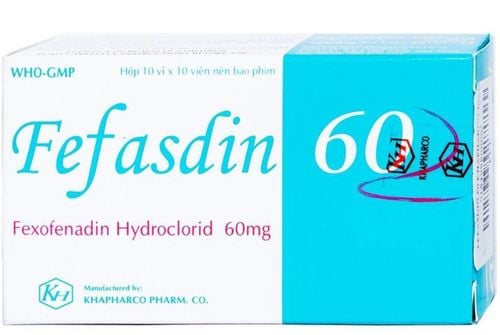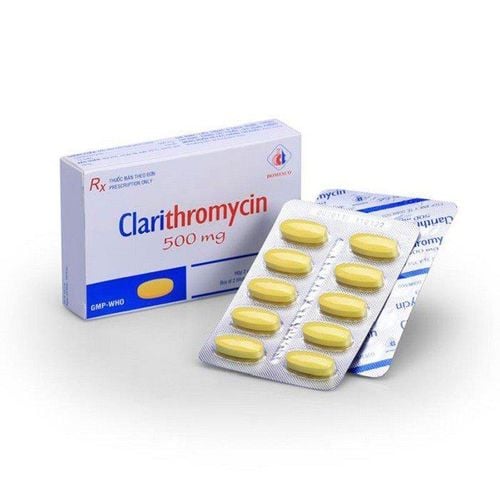This is an automatically translated article.
Aticef 500 is a drug used mainly to treat patients with infections of the respiratory tract, urinary tract, skin and soft tissue,... Before and during treatment with Aticef 500, the patient It is important to pay attention to taking the medicine according to the regimen prescribed by the doctor, avoiding self-medication without the recommendation.
1. What is Aticef 500?
Aticef 500 is a pharmaceutical product manufactured by Hau Giang Pharmaceutical Joint Stock Company, in the form of hard capsules, silver green / silver white. Aticef 500 is packaged in a box of 2 blisters x 7 tablets, each capsule contains the following ingredients:
Main ingredients: Cefadroxil monohydrate with the corresponding content of 500mg. Other excipients just enough for one tablet: Talc powder, magnesium stearate, aerosil, sodium starch glycolate.
2. Indications and uses of Aticef 500
2.1. Indications for use of drugs Aticef 500 Drugs Aticef 500 are often indicated to treat some specific bacterial infections below:
Respiratory tract infections, such as otitis media, laryngitis, pharyngitis, tonsillitis, acute / chronic bronchitis, lobar pneumonia, bronchopneumonia, lung abscess,... Urinary tract infections such as cystitis, nephritis, acute or chronic pyelonephritis, inflammation urethra. Genital tract infections. Skin and soft tissue infections such as abscesses, lymphadenitis, bed sores, cellulitis, boils, mastitis. Some other infections such as septic arthritis or osteomyelitis. 2.2. What are the uses of Aticef 500? 2.2.1. Pharmacodynamics The main active ingredient cefadroxil in Aticef 500 is a semi-synthetic antibiotic, belonging to the 1st generation cephalosporin group. This active ingredient has a bactericidal effect, preventing the growth and division of bacteria through inhibition of bacterial cell wall synthesis.
Cefadroxil is effective against many Gram (+) bacteria such as Haemolytic Streptococcus, Staphylococcus, Streptococcus pyogenes, Streptococcus (Diplococcus) pneumoniae, and some gram (-) bacteria such as Haemophilus influenzae, Klebsiella pneumoniae, Shigella, Proteus mirabilis, Escherichia coli, and Salmonella.
2.2.2. Pharmacokinetics Active ingredient cefadroxil is rapidly absorbed from the gastrointestinal tract, persists in the acidic environment of the stomach and is not affected by food. According to studies, cefadroxil is relatively poorly bound to plasma proteins (only about 20%).
The plasma half-life of cefadroxil is within 1.5 hours (in patients with healthy renal function) and tends to last from 14 to 20 hours (in patients with renal impairment). Immediately after absorption, the active substance cefadroxil is widely distributed throughout body fluids and tissues. The drug is excreted in breast milk and may cross the placenta when administered.
In general, cefadroxil is not metabolized in the body. Approximately more than 90% of a dose is excreted unchanged in the urine after 24 hours. Following a single 500 mg dose of cefadroxil, peak urinary concentrations of the drug reached approximately 1800 mcg/ml. In addition, this active substance is also eliminated at a large rate by artificial renal dialysis.
3. Dosage and how to use Aticef 500
3.1. Dosage of Aticef 500 The following is the dosage of Aticef 500 according to the general recommendation of the doctor:
Children > 40kg and adults: Take 1-2 tablets (corresponding to a dose of 500 - 1000mg) x 2 times/day. Patients with skin and soft tissue infections: Take 2 tablets (corresponding to a dose of 1000mg) x 2 times / day. Patients with mild to moderate respiratory and bone infections: Take 1 tablet (corresponding to a dose of 500mg) x 2 times/day. In case of severe infection can take 2 tablets (1000mg dose) x 2 times / day. Children ≥ 6 years old: Take 1 tablet (500mg dose) x 2 times / day. Patients with renal impairment: The dose of Aticef 500 may be adjusted in cases of renal failure with creatinine clearance less than 50ml/min. The starting dose for this patient population is 1-2 tablets (corresponding to a dose of 500-1000mg). Subsequent drug doses, patients can be adjusted based on creatinine clearance and the duration of treatment needs to be maintained at least from 5 to 10 days, specifically: Creatinine clearance from 0 to 10ml/min: Oral from 1-2 tablets (500-1000mg dose), 36 hours apart.
Creatinine clearance from 11-25ml / min: Take 1-2 tablets (500-1000mg dose), each dose is 24 hours apart.
Creatinine clearance from 26 - 50ml / min: Take 1-2 tablets (dose 500 - 1000mg), each dose is 12 hours apart.
3.2. How to use the drug Aticef 500 Active ingredient cefadroxil is relatively stable to acid and does not depend on meals. Therefore, patients should take Aticef 500 orally before or during meals. The use of drugs with food can help patients significantly reduce symptoms of discomfort in the stomach - duodenum.
4. What to do if you overdose or miss a dose of Aticef 500?
4.1. How to deal with drug overdose Aticef 500 When overdosing the drug can lead to acute symptoms such as diarrhea, nausea, vomiting. Occasionally, neuromuscular hypersensitivity, causing convulsions, occurs, especially in patients with renal failure.
In the case of an overdose of Aticef 500mg, the patient should be treated as soon as possible and treated with hemodialysis to remove the drug from the blood. In addition, the doctor can also apply supportive measures to protect the respiratory tract and give fluids to the patient. After performing gastrointestinal lavage or cleansing, the doctor will proceed to address the symptoms of overdose that the patient is experiencing.
4.2. How to handle the situation of forgetting a dose of Aticef 500 If a dose of Aticef is forgotten, the patient needs to take up the dose as soon as possible. In case it is too close to the time for your next dose, it is best to skip the previous dose and take your next dose as scheduled by your doctor. Avoid taking a double dose as this can lead to drug overdose reactions.
5. Some side effects when using Aticef 500
The treatment of bacterial infections with Aticef 500 can potentially have a number of side effects ranging from common to rare, including:
Common side effects: Diarrhea, nausea or abdominal pain. Uncommon side effects: Pruritus, rash, urticaria, eosinophilia, vaginitis, genital pruritus, candidiasis, testicular pain or reversible elevation of transaminases. Rare side effects: Fever, anaphylaxis, gastrointestinal disturbances, serum sickness, thrombocytopenia, neutropenia, hemolytic anemia, angioedema, Stevens-Johnson syndrome, positive Coombs test , Lyell's syndrome, hepatitis, obstructive jaundice, arthralgia, headache, convulsions, agitation, nephrotoxicity or reversible interstitial nephritis. When you notice any of the reactions listed above, you should quickly contact a qualified doctor / pharmacist for assistance. In the case of anaphylaxis, the patient needs immediate medical attention as it is a serious life-threatening condition that can cause dangerous complications or even death if no first aid measures are taken in time.
6. What drugs may interact with Aticef 500?
Drug Aticef 500mg when used in combination with some other drugs, there may be an interaction situation. This reduces the bioavailability and effectiveness of the drugs significantly. The following is a list of drugs that may interact with Aticef 500:
Probenecid in combination with Aticef may decrease the elimination of cefadroxil. Cholestyramine used in combination with Aticef reduces the absorption of cefadroxil. Co-administration of aminoglycosides or furosemide with Aticef 500 may increase nephrotoxicity. In order to prevent the risk of drug interactions, patients need to provide full information about all medications they are taking to their doctor, including prescription / non-prescription drugs. prescriptions, supplements, herbs, vitamins or supplements.
7. Some things to note when using and storing Aticef 500
7.1. Contraindications to the use of the drug Aticef 500 The use of Aticef 500mg should be avoided in patients who are allergic or have a history of hypersensitivity to cephalosporin antibiotics. In addition, the drug is contraindicated for people who are allergic to the excipients in the drug.
7.2. What precautions should be taken while using Aticef 500 Tablet? Here are some things to pay special attention to during the treatment with Aticef 500, including:
Caution should be exercised when using the drug for penicillin-sensitive subjects, people with gastrointestinal disease, colitis. colon or renal failure (creatinine clearance < 50 ml/min). Long-term use of the drug may increase the risk of developing a large number of non-susceptible strains. Caution should be exercised when using Aticef 500 in combination with aminoglycoside antibiotics. Caution should be exercised when administering the drug to premature infants or neonates because there have not been many studies on the safety and efficacy of Aticef in these populations. Pregnant women should only use the drug when prescribed by a doctor. Finally, the drug should be stored in a dry, high place, the temperature does not exceed 30 degrees Celsius and avoid sunlight. In addition, you need to keep the medicine out of the reach of children and pets.
Please dial HOTLINE for more information or register for an appointment HERE. Download MyVinmec app to make appointments faster and to manage your bookings easily.













